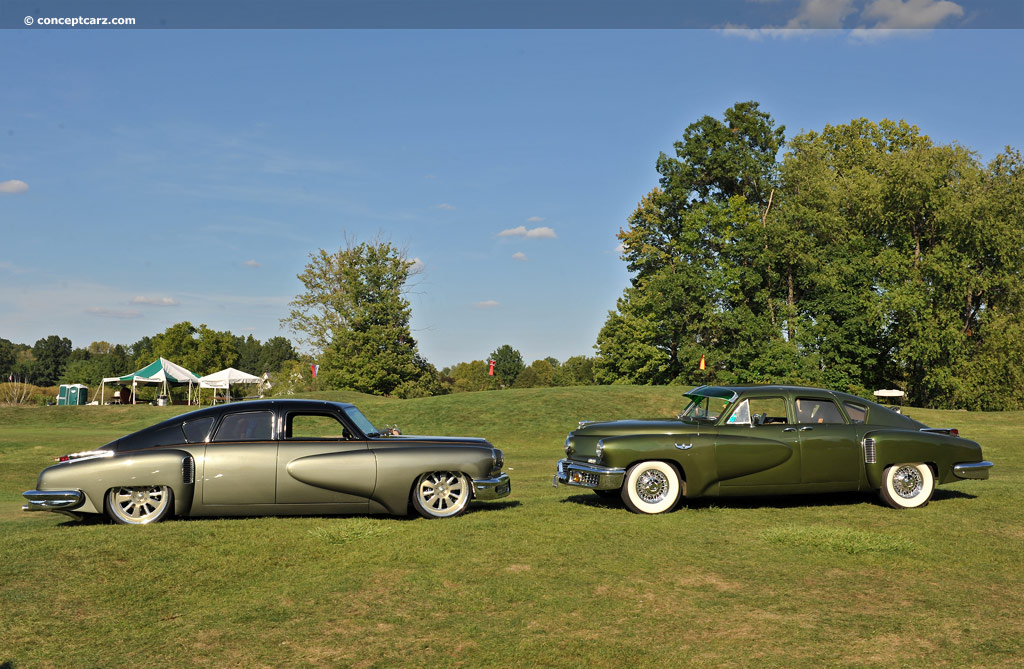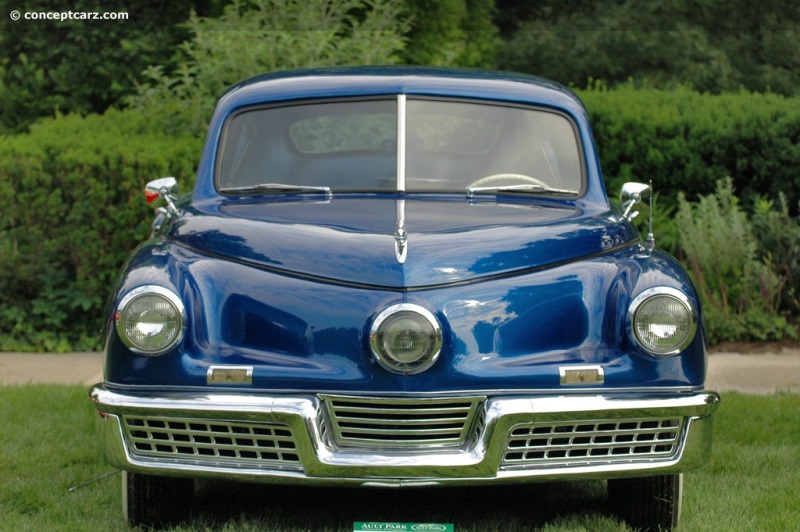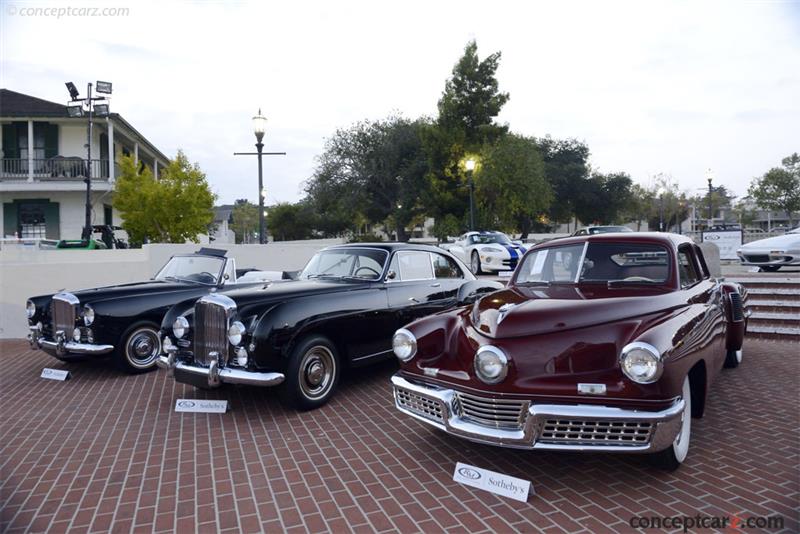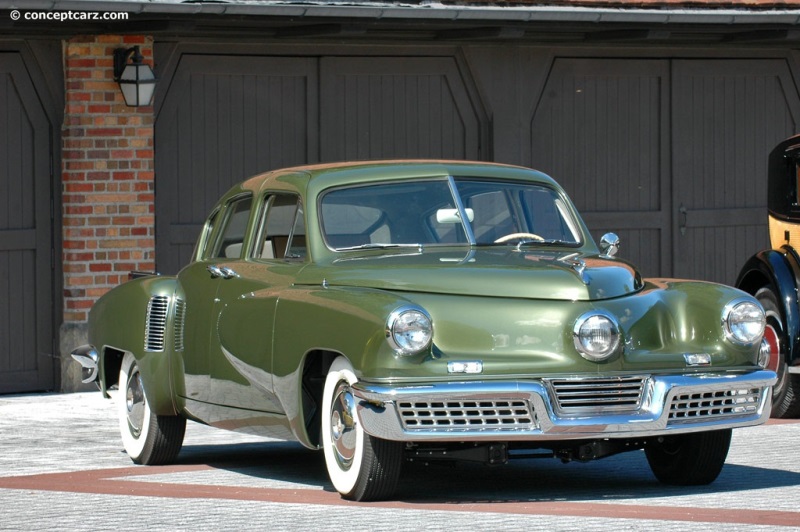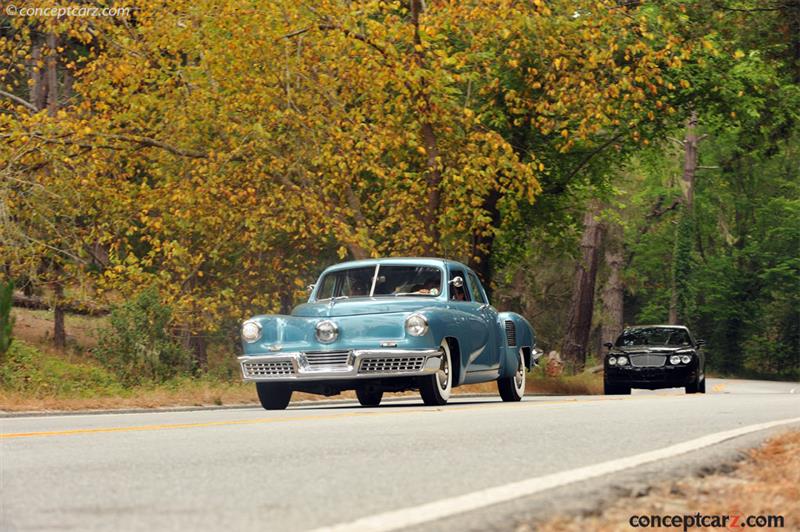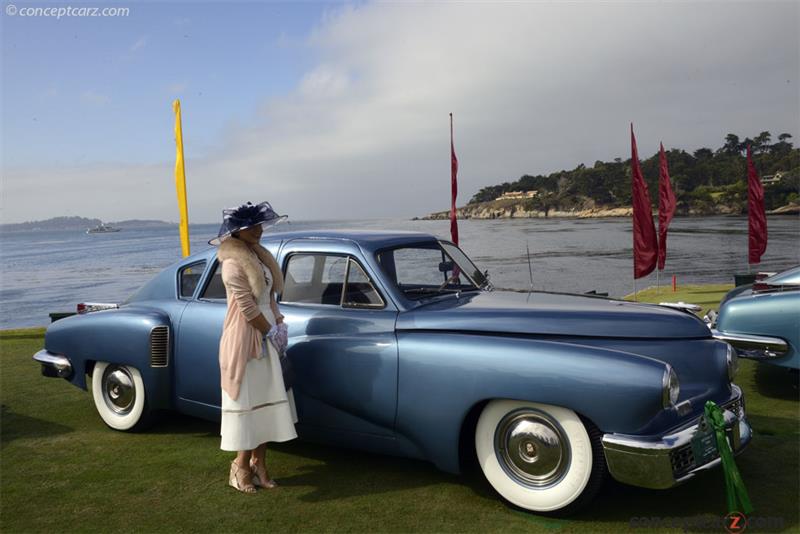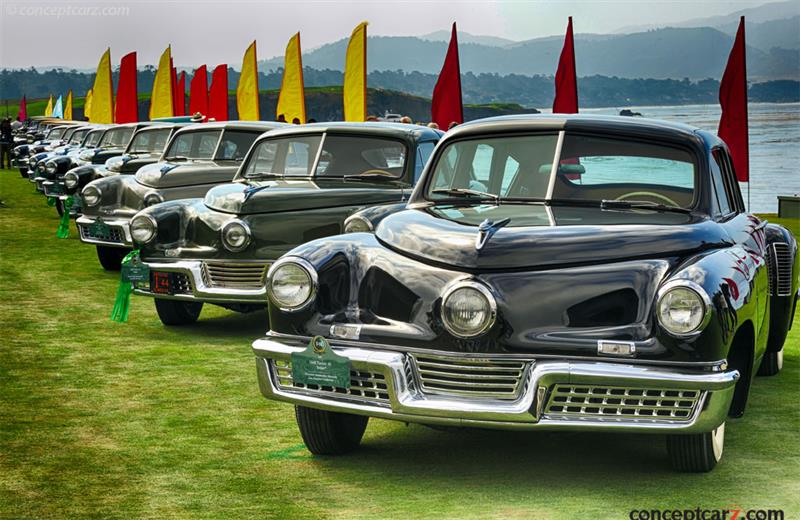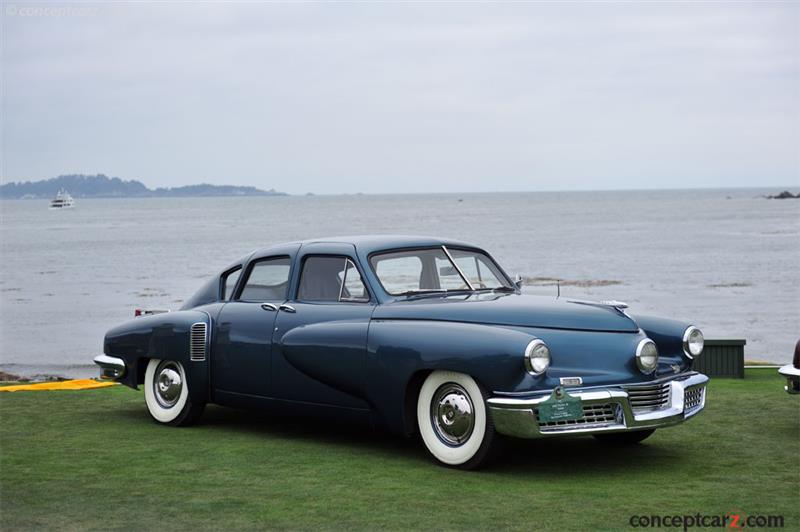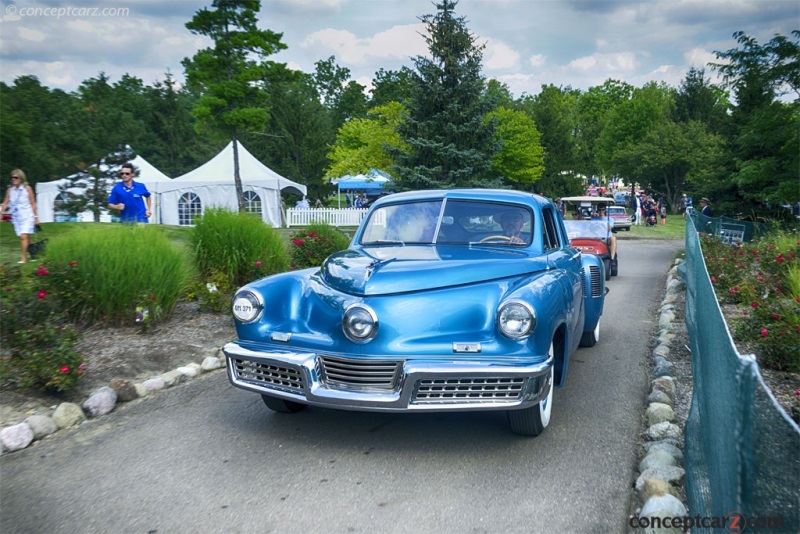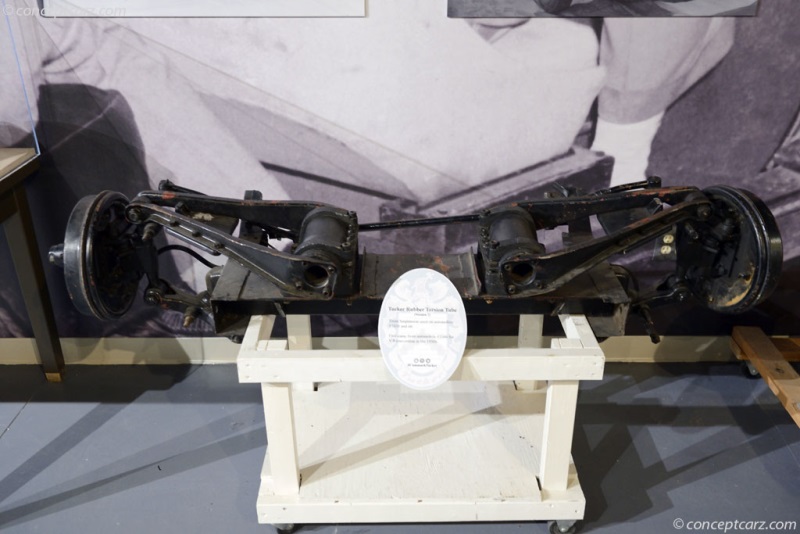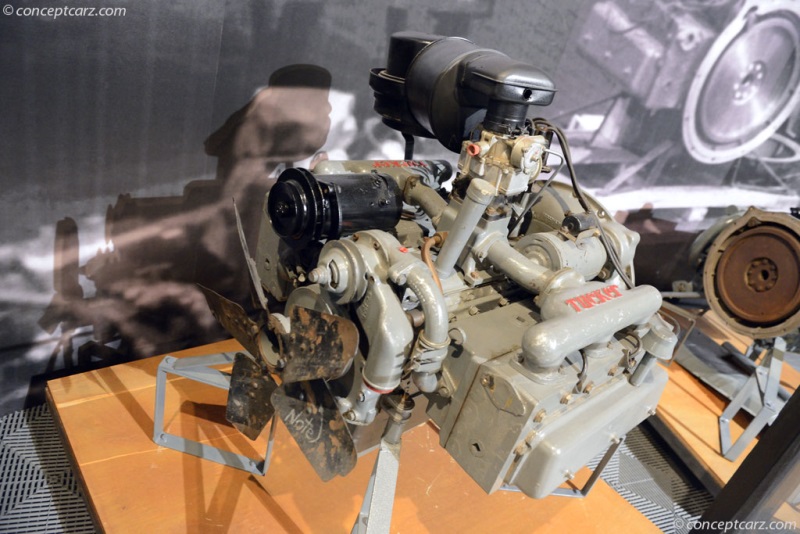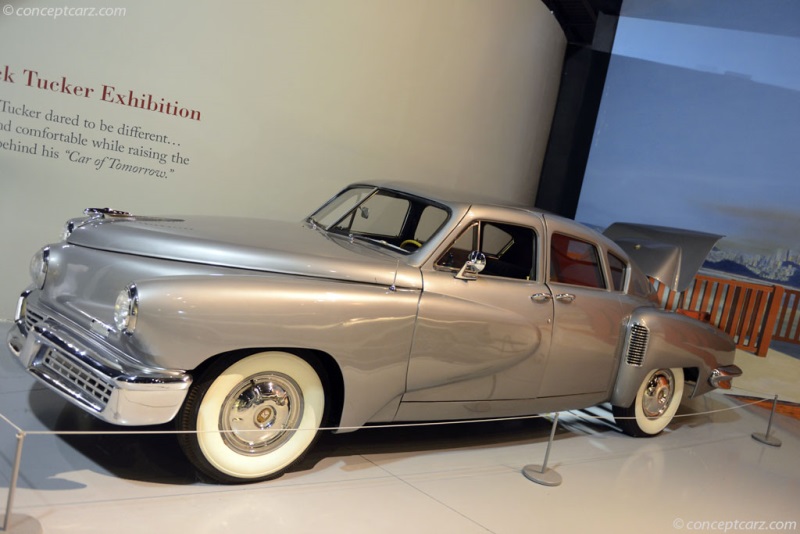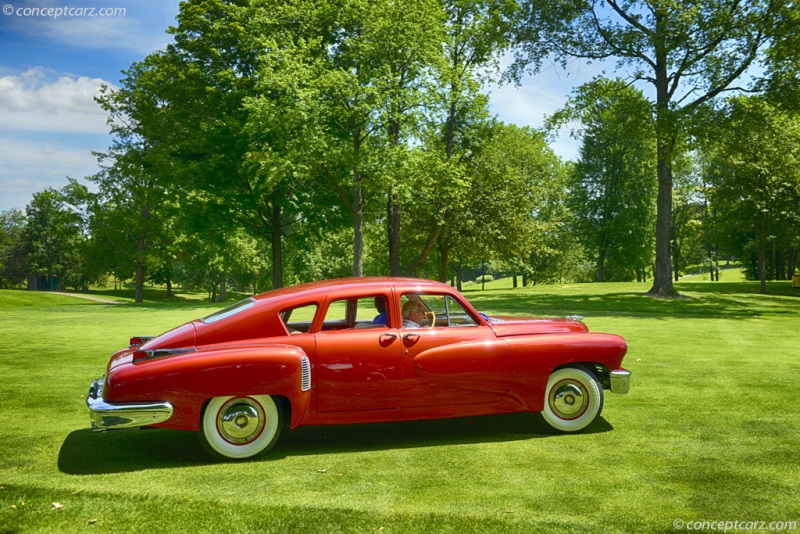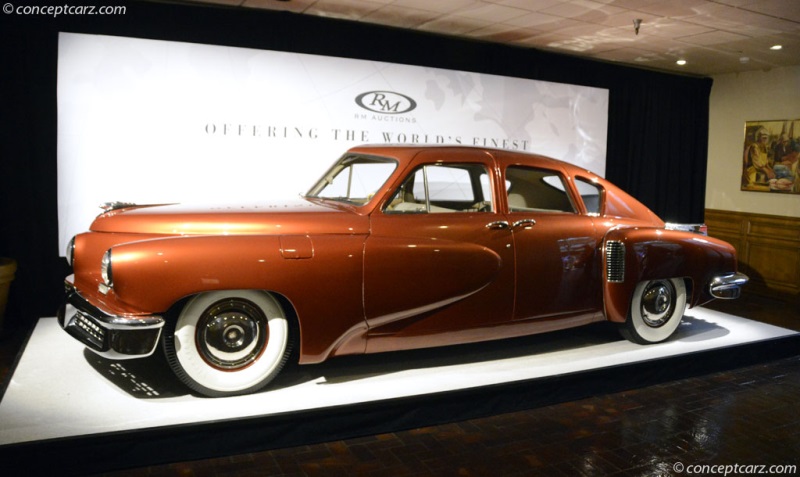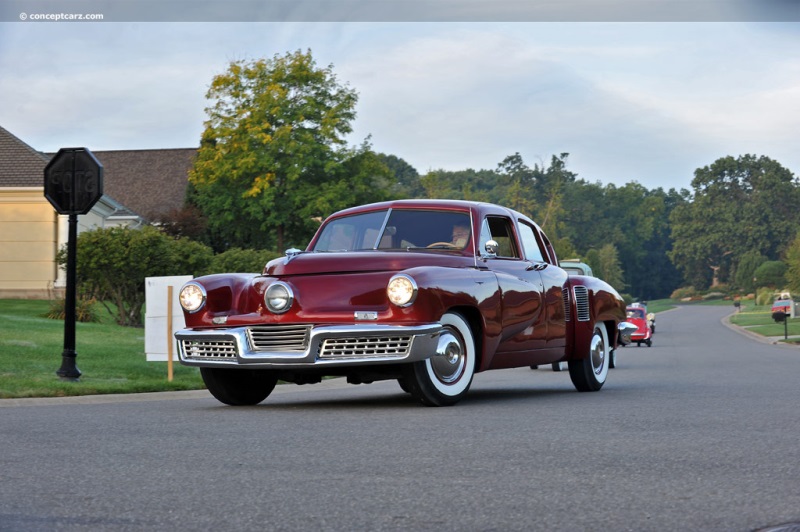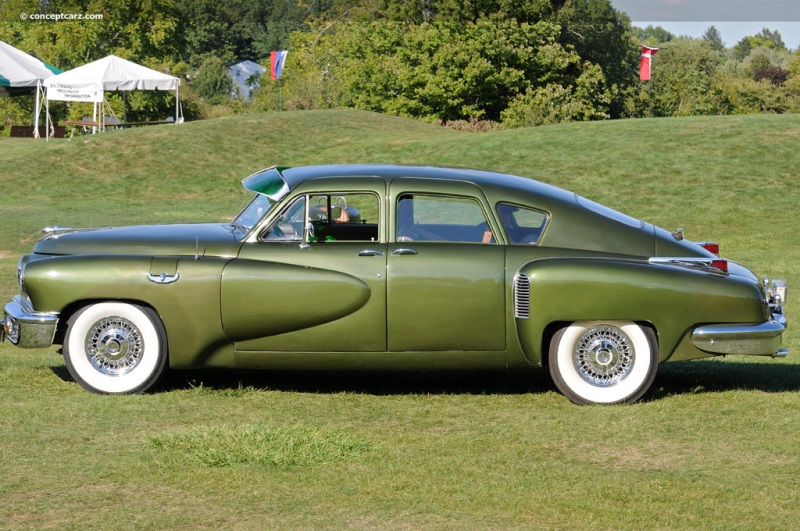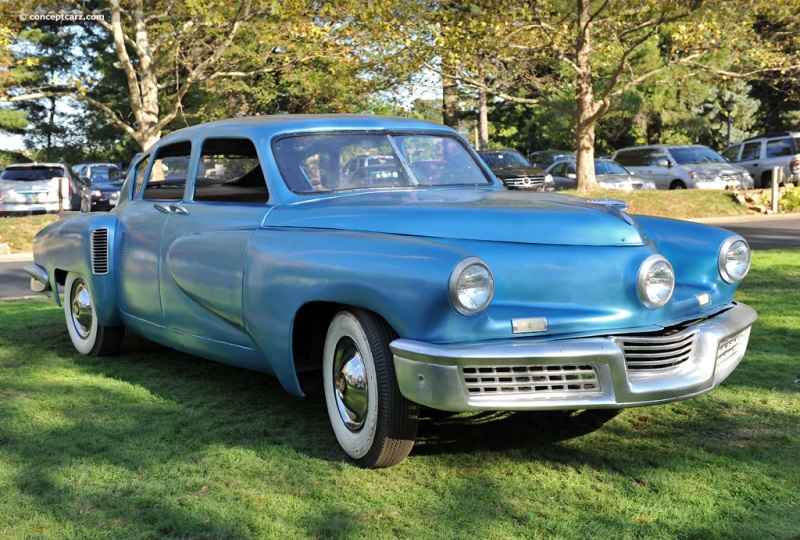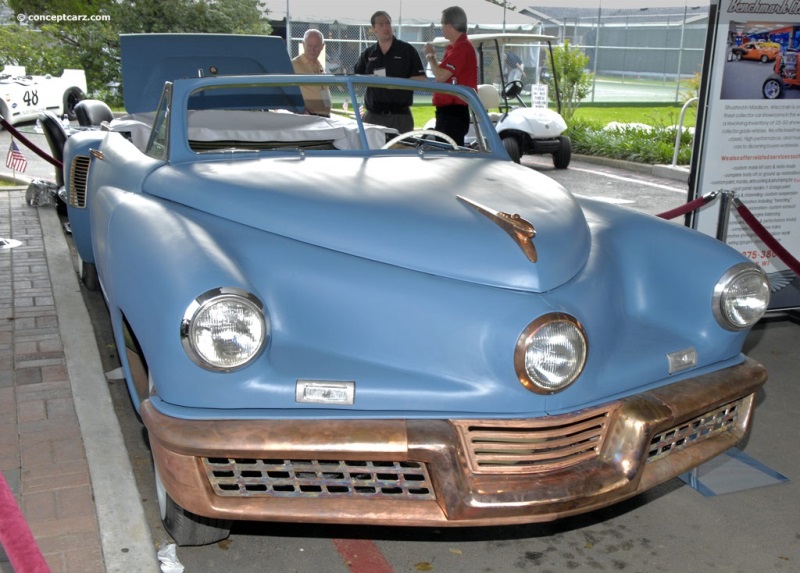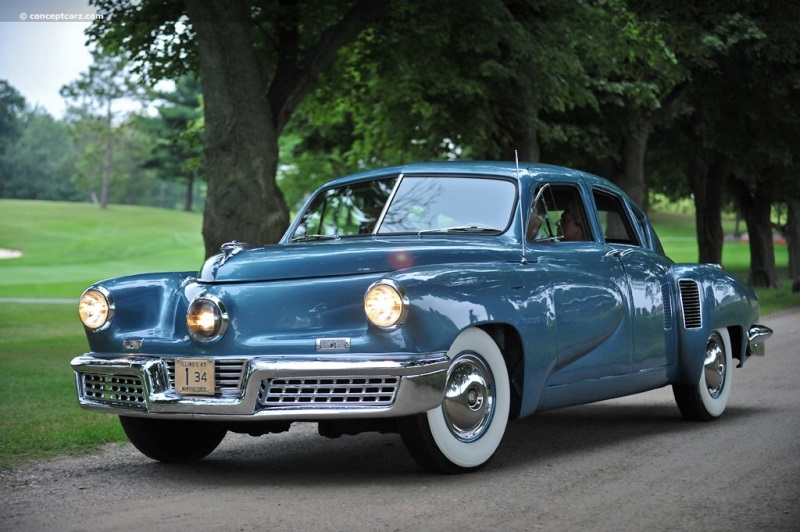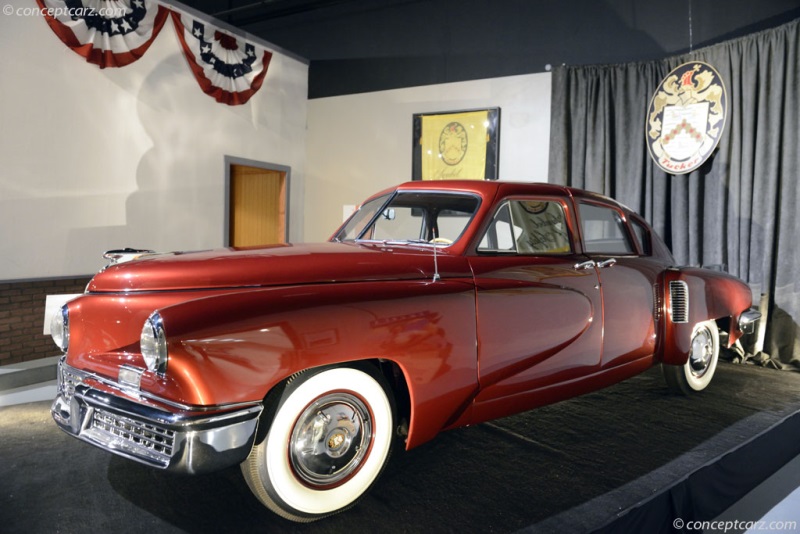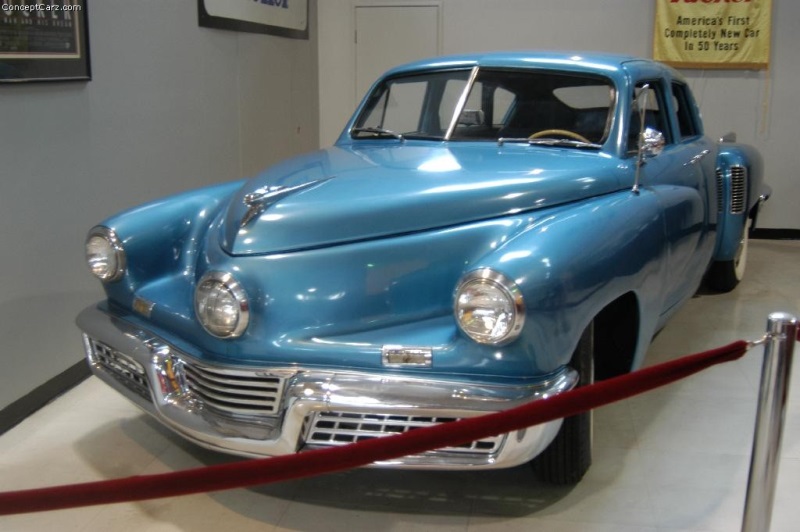Though only 51 examples were ever produced, the work of Preston Tucker has firmly cemented itself in history and established a legacy that resounds with automotive enthusiasts from all corners of the world. After the close of the Second World War, Tucker began work on a new breed of automobiles that would become an engineering marvel and a masterpiece of design. 
Sedan
Chassis #: 70052026013
Engine #: 1036
View info and history
Auction entries : 2The Genesis
When World War II ended, a unique opportunity presented itself which allowed newcomers the opportunity to gain a foothold in the cut-throat automobile industry. The government had frozen the sale of consumer vehicles on January 1st, 1942, to divert resources towards war materiel production. When civilian automobile production resumed after the war, established automakers hastily re-introduced mildly updated pre-war products to meet demand. Studebaker was the first to introduce an all-new postwar model, and most manufacturers would introduce their all-new products before the close of the decade. Small automakers like Tucker could develop new cars faster than large legacy automakers, allowing them to establish a presence within the industry.Preston Thomas Tucker
Preston Tucker was a veteran of the automobile industry, having worked as an office boy for the Cadillac Motor Company, later on the Ford Motor Company assembly line, and eventually sold Studebakers. He was a gifted salesman, selling Stutz automobiles for Ivor Schmidt and later became general sales manager for the John T. Fisher Motor Company selling Chryslers. In 1933, he moved to Buffalo, New York, to become regional sales manager for Pierce-Arrow automobiles. Two years later, he moved back to Detroit, Michigan, and worked as a Dodge salesman for Cass Motor Sales. Tucker's passion for motorsports led him to Harry Miller, maker of more Indianapolis 500-winning engines than any other during this period. Although successful in motorsports, Miller could not outrun the effects of the Great Depression. When Miller declared bankruptcy in 1933, Tucker persuaded him to join him in building race cars, forming 'Miller and Tucker, Inc.' in 1935. Met with both failure and success, the Miller and Tucker, Inc. venture continued until Miller's death in 1943.
Sedan
Chassis #: 70052026013
Engine #: 1036
View info and history
Auction entries : 2Tucker's vast experience in the automobile industry, helped along by his outgoing personality and his involvement at Indianapolis, allowed him to meet many influential and talented people, including the Chevrolet brothers and chief mechanic/engineer John Eddie Offutt, who would later help Tucker develop and build the first prototype of the Tucker 48. While selling Studebakers, Tucker had met Michael Dulian, another salesman, who would become sales manager for the Tucker Corporation. Tucker designed a power-operated gun turret, known as the 'Tucker Turret,' which was initially produced at his Ypsilanti Machine and Tool Company, operating out of a remodeled barn on his property. Unfortunately for Tucker, his patent and royalty rights were confiscated by the United States. Through lawsuits, Tucker spent years trying to recoup royalties for the use of his patents on the turret.The Tucker Aviation Corporation (Tucker's first corporation) was formed in 1940 and also operated at his shop behind his Michigan home. With financial backing through stock certificates, Tucker developed the design for a fighter aircraft, the Tucker XP-57. It caught the interest of the United States Army Air Corps (USAAC), and a single prototype was started, however development was slowed due to financial problems, and eventually, the contract lapsed. Andrew Jackson Higgins of Higgins Industries acquired Tucker Aviation Corporation in March 1942. The Tucker Corporation
The December 1946 issue of Science Illustrated magazine showed an early Tucker rendering of a design proposal created by George Lawson. There was a photo of a 1/8 scale model blown up to appear full-sized, titled the 'Torpedo on Wheels'. Well received by the motoring public, stylist Alex Tremulius was hired by Tucker on December 24, 1946, to complete the prototype design. Tremulius was given six days to finalize the design; Tremulis's preliminary design was approved on December 31, 1946.
Sedan
Chassis #: 70052026013
Engine #: 1036
View info and history
Auction entries : 2The Tucker automobile was initially to be called the 'Tucker Torpedo,' but this was quickly changed due to the horrors it conjured of World War II. Instead, it was called the 'Tucker 48.' During March of 1947, Tucker displayed Tremulis's design sketch in a full-page advertisement in many national newspapers claiming, 'How 15 years of testing produced the car of the year'. A second advertisement described many of the prototype features of the car, many of which would not make it to the final design. Before the design was finalized, Tucker hired the J. Gordon Lippincott design firm of New York to create an alternate design for the body. Only the horizontal taillight bar designs and front end were used for the final car. 
Sedan
Chassis #: 70052026013
Engine #: 1036
View info and history
Auction entries : 2Dodge Chicago Aircraft Engine Plant
The Dodge Chicago Aircraft Engine Plant was the largest factory building in the world, and had been used to build the Wright R-3350 Cyclone engines for B-29 Superfortress aircraft during WWII. Tucker and his colleagues obtained the factory from the War Assets Administration with the goal of producing the Tucker automobile under a single roof. The remaining space was intended to be filled by other Tucker ventures, including contracts with the United States Air Force. Needless to say, the lease was expensive, and Tucker needed to raise $15 million in capital by March 1947. This was accomplished by selling dealership rights and floating a $20 million stock issue through the Chicago brokerage firm Floyd D. Cerf. By 1947, the Tucker Corporation had over $17 million in the bank, and although that was enough to satisfy the lease, Tucker was not able to move in until September 1947 due to disputes and counter-claims over the plant between the Lustron Corporation and Tucker. Development of the car was ongoing at Tucker's Michigan machine shop, but the delayed move to the factory meant that Tucker was nearly a year behind his intended schedule. Tucker encountered another delay when the WAA rejected his bids to obtain two steel mills to provide raw materials for his cars.Intended and Actual Production
Tucker estimated that the factory and his workforce could produce - and the market could sustain - 60,000 cars per year. During the first four months, production was anticipated to reach 140 units per day, growing to 300 units per day in the months that followed. Including the prototypes, total production fell far short of those lofty goals, with just 51 examples built before the company was forced to declare bankruptcy and cease all operations on March 3, 1949. A total of 58 frames and bodies were built at the factory. Thirty-six sedans were finished before the factory closed; after the closure but before the liquidation of his assets, Tucker and a small number of employees assembled an additional 14 sedans, for a total of 50. A 51st car was partially completed. At least two (chassis number 1052 and 1057) were not completed at the Tucker factory and are not technically considered one of the original 51 cars. Chassis #1052 was completed in 2015 using parts collected over many years, including the front sheet metal sourced from Tucker #1018. Chassis #1057 was a prototype being worked on by Alex Tremulis for the 1949 model year and was one of eight incomplete body shells (believed to be #1051–1058) left on the assembly line at the time the Tucker plant was closed. In 2010, #1057 was converted into a convertible.
Sedan
Chassis #: 1034
Engine #: 33541
View info and history
Auction entries : 2Each Tucker automobile that was built was unique, essentially a 'prototype' that explored engineering concepts and design features.The first Tucker prototype sedan produced was known as the 'Tin Goose,' and was first shown to the public on June 19th, 1947.The Tucker 48 Mechanical Specification
The Tucker sedan was futuristic, daring, and sophisticated. Safety and innovation were prominent themes throughout the vehicle, using an unconventional rear engine, rear-wheel drive configuration, and a third, centrally located directional headlamp that would activate at steering angles of greater than 10 degrees.
Sedan
Chassis #: 1034
Engine #: 33541
View info and history
Auction entries : 2Safety
The Tucker rested on a perimeter frame and had a wheelbase size of 128 inches, a length of 219 inches, a width of 79 inches, and stood 60 inches tall. The perimeter frame and a roll bar integrated into the roof provided crash protection. The transmission and engine were mounted on a separate subframe, secured by six bolts. Tucker envisioned complete engine swaps taking less than an hour, with the entire drive train being lowered and removed within minutes.The windshield was built of shatterproof glass and designed to pop out in a collision. The steering box was positioned behind the front axle to protect the driver in a front-end accident (one of Preston Tucker's patents was for a collapsible steering column design). The steering columns were donated by Ford and were sourced from the 1941 Lincoln. The center-mounted headlight moved with the steering wheel, providing light in the direction the vehicle would be traveling. The door releases and interiors were from the Lincoln Zephyr. Crash Chamber
The Tucker 'crash chamber' was a padded area ahead of the passenger seat, occupying the location traditionally used by the glove box. This area was designed as a safe, protected area that front-seat passengers could use in the event of an accident. The Tucker did have a glove box, located on the front door panels. The Tucker had a padded dashboard for safety, devoid of protruding buttons and gauges. All controls and the instrument panels were grouped around the steering wheel, within easy reach of the driver. The front and rear seats could be interchanged which aided in the reduction of wear. Discarded Innovation
The Tucker was given many innovative features, but many were attempted or tested and discarded due to complexity, development time, or costs. Among the list of abandoned innovations were disc brakes, self-sealing tubeless tires, magnesium wheels, and a direct-drive torque converter transmission.Suspension
The unique design and configuration of the Tucker required a simiarly unique suspension setup. Problems with stiffness, front-wheel corner lift, and weakness were encountered before a suitable solution was found.
Sedan
Chassis #: 1015
View info and historyThe test bed and the prototype Tucker used a double-rubber disc-type setup, similar to Harry Miller's race cars. This setup was unable to sustain the loads of a passenger car. The rear rubber torsion tube suspension design on chassis number 1001 and 1002 was very stiff and suffered from severe toe-in during heavy braking. Additionally, the rear wheels could not be removed without removing the suspension, fender, and rear wheel arch fender design. Beginning with chassis number 1003, a new fender shape was used to allow easy tire changes. Chassis number 1003 to 1025 were given a rubber sandwich-type suspension with a rubber block sandwiched between the upper and lower A-arms. Beginning with chassis number 1026, a modified version of the rubber torsion tube was used.Engines
589 Cubic-Inch Flat-6
Working with Ben Parsons, then owner and president of the Fuelcharger Corporation, a 589 cubic-inch flat-6 cylinder engine was developed and intended to develop nearly 200 horsepower and 450 lb-ft of torque at only 1800 RPM. It had fuel injection, hemispherical combustion chambers, and overhead valves operated by oil pressure (rather than a camshaft). Each valve was designed to receive appropriately timed direct oil pressure at proper intervals via an oil pressure distributor positioned in line with the ignition distributor. The pistons were built of aluminum and magnesium castings with steel-plated cylinder linings.Six prototype 589 CID engines were built, but were only installed in the test chassis and the first prototype. The engine was extremely loud, and the high-voltage starter required the use of outside power to get the engine started. The high oil pressure required a 24-volt electrical system and up to 60 volts to get it started. Instead of the promised 150 hp, the engine produced approximately 88 hp. The valve train did not work properly at lower RPMs, as the oil pressure required to maintain valve function was not achieved until the engine was operating at higher RPMs.
Sedan
Chassis #: 1015
View info and historyThe Franklin O-335 Engine
The 589 cubic-inch engine was innovative, but its numerous shortcomings sent Tucker seeking alternatives. Nearly a year had been wasted on the 589 CID engine, another setback for the young company. A solution was not easily forthcoming due to the rear engine configuration and size of the engine bay. A Lycoming aircraft engine was attempted, but it was too big and did not fit. A 6 ALV 335 Franklin helicopter engine (flat-6, air-cooled, Franklin O-335 made by Air Cooled Motors) fit, and its output exceeded 150 horsepower (at 166 hp). Tucker purchased four engines at $5,000 each, and numerous modifications were required to adapt the aircraft engine for road-going purposes. For unknown reasons, the air-cooled 334 CID engine was converted to water cooling. The engine required extensive modifications, but it was a workable solution, so Tucker acquired Air Cooled Motors for $1.8 million. Tucker canceled all of the company's aircraft contracts, redirecting all available resources to the production of automotive engines. This was, perhaps, a poor decision as the company forfeited substantial income from the 65% of post-war U.S. aviation engine production contracts it held. The Franklin O-335 engine was installed horizontally with its driveshaft pointed forward, towards the front of the car. Transmission
Cord Transmission
With the engine located at the rear, an unconventional transmission was needed. A workable solution was found using the Pre-Selector (Bendix 'Electric Hand' electro-vacuum shifting mechanism) unit that had been installed in the front-engine/front-wheel drive Cord 810/812. The 4-speed transmission had a reputation for being faulty, but it was a quick solution, designed to point forward towards the front of the car. Installed in the Tucker, it succeeded in getting the cars built and on the road, but quickly proved unable to cope with the power and torque of the O-335 engine. Nevertheless, it worked and had a reverse gear. After searching junkyards and used car dealers, a total of 22 used transmissions were found. They were brought to the Ypsilanti Machine And Tool Company, where they were refurbished and mated to the O-335. Around 18 of the 22 Cord transmissions were usable and installed in production Tucker vehicles.
Sedan
Chassis #: 70052026013
Engine #: 1036
View info and history
Auction entries : 2Ypsilanti Y-1 Transmission
The Cord transmission had weak gear-teeth, lacked adequate lubrication, and the main shaft often warped under load. Only 22 used examples had been found, a far cry from the planned production of 60,000 cars a year. A suitable alternative was desperately needed.The Ypsilanti Machine and Tool Company was tasked with redesigning the Cord transmission for mass production. Tucker and his engineers used the same basic indirect transmission design but with a lengthened case, stronger gears, and all-new shafts and electro-vacuum controls. It used the Bendix-designed electric vacuum shift mechanism but without mechanical linkage to the steering column shift lever.Dubbed the Tucker Y-1 (for Ypsilanti-1), it was installed in a few Tuckers. Had Tucker production succeeded in greater quantities, these transmissions would have required further development as they suffered from vacuum leaks and electrical connection issues. Tuckermatic Drive Transmission
When the Cord Pre-Selector and the Ypsilanti Y-1 transmissions failed, Tucker enlisted Warren Rice to aid in designing a solution. Mr. Rice was the creator of the Buick Dynaflow transmission, and the solution he designed to cope with the Franklin O-335's power and torque was a unique continuously variable transmission called the 'Tuckermatic.' It had 27 basic moving parts, a single rear-mounted torque converter, and a variable pitch torque converter that allowed a continuously variable drive ratio with two forward gears and a single reverse gear. Since no lower gear selections were necessary, a multi-gated selector was not needed. A single Tucker (chassis #1026) survives with the Tuckermatic installed. Its Tuckermatic R-1-2 unit is one of three different versions of the Tuckermatic made, the R-1, R-1-2, and R-3 (R for Warren Rice, its designer). The first version, the R-1, was not installed on any of the final cars since it required the engine to be off in order to select a gear. The R-1-2 was improved by adding a layshaft brake to allow gear selection while the engine was running. This version was installed on cars #1026 and 1042 only. The R-3 version had further improvements, including a centrifugal clutch to help shift between forward and reverse even further, but it was never installed in any of the final cars. Because the two torque converters on the Tuckermatic made the engine/transmission unit longer, the fuel tank in the Tucker '48 had to be relocated from behind the rear seat to in front of the dashboard for all Tuckers from car #1026 forward, even though only two of them actually had the Tuckermatic installed. The vehicle's weight distribution, however, improved.Chassis number 1026 was a pivotal car in Tucker's suspension configuration, as it was the first to use a modified version of the rubber torsion tube with the tone-in braking problem corrected. Chassis #1025 and prior used mechanical linkage for the Cyclops eye; chassis #1026 and beyond used a new cable-operated system.Chassis #0142 was also fitted with the special Tuckermatic transmission, but it was destroyed numerous years ago.Color
Exterior Paint Color Codes
100: Black
200: Waltz Blue
300: Green
400: Beige
500: Grey (Silver)
600: MaroonInterior Trim Color Codes
900: Green
920: Blue
940: BeigeIntroduction
The Tucker 48 made its world premiere on June 19, 1947, and over 3,000 people were in attendance at the factory in Chicago for the unveiling of the first prototype. Lofty promises had been made, and millions of dollars were invested. Many of the era's greatest engineers and designers had lent their talents in creating the Tucker, and the endless list of problems encountered during development had been corrected. It was not enough; not enough development time and not enough money. The night before the debut, the prototype's independent suspension arms snapped under the car's weight. Repairs were made, and the car made its debut on time, but under the spotlight, it was clearly evident that the Tucker was not ready for production. The experimental 589 engine required the use of outside power to get the engine to start. Tucker's solution was to keep the engine running during the entire event. This may have worked had the engine been quiet. Instead, it was extremely loud. Tucker's solution was to have the band play as loud as possible. The public and journalist's first impression of the Tucker was negative, and its reputation suffered. When the final design was in place, Tucker was able to repair the reputation by showing them in towns across the country. Several cars were brought brought to the Indianapolis Motor Speedway where they were put through a series of endurance testing. Chassis number 1027 was traveling 95 miles per hour when it crashed and rolled three times. The windshield popped out as designed, and the driver (Eddie Offutt) was able to walk away from the crash. A damaged tire was replaced and the car was started and driven off the track, proving to be both safe and durable. Demise of the Tucker Automobile
Preston Tucker had raised $17 million in a stock issue. When more funds were needed, he sold dealerships and distributorships throughout the country. Additional funds were raised through the Tucker Accessories Program, where prospective buyers could purchase accessories to secure a spot on the Tucker waiting list. The list of accessories included a radio, luggage, and seat covers for their Tucker automobile. The Accessories Program raised an additional $2 million. Veterans of World War II were given preference on the waiting list; non-veterans were given a much lower priority. The Accessories Program guaranteed a spot on the Tucker dealer waiting list for a Tucker 48 car. The U.S. Securities and Exchange Commission and the United States Attorney investigated this concept, and although all charges were eventually dropped, the company executives were indicted.Production delays, numerous problems throughout development, a lack of raw materials from a failed bid to obtain two steel mills, a poor public debut, negative publicity, and indictments led to the quick demise of the Tucker automobile. Soon after the Tucker automobiles began rolling off the assembly line in the spring of 1948, the Securities and Exchange Commission began investigating the allegations of mail fraud and other violations. The negative publicity sent the stock plummeting and the facility was forced to close.
by Daniel Vaughan | Sep 2018
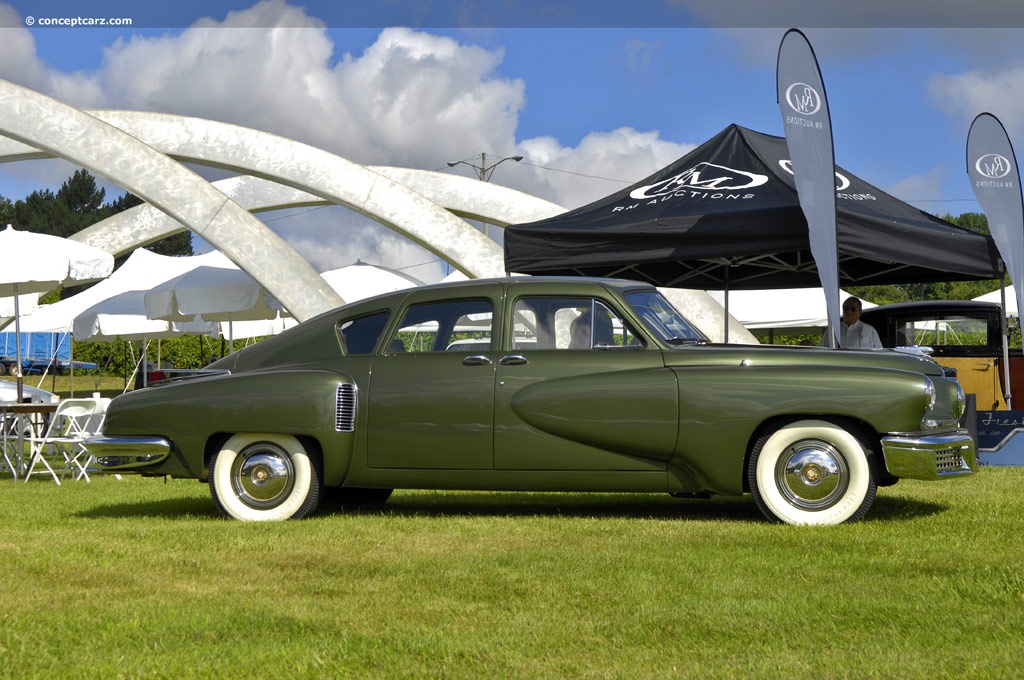
Sedan
Chassis #: 70052026013
Engine #: 1036
View info and history
Auction entries : 2
When World War II ended, a unique opportunity presented itself which allowed newcomers the opportunity to gain a foothold in the cut-throat automobile industry. The government had frozen the sale of consumer vehicles on January 1st, 1942, to divert resources towards war materiel production. When civilian automobile production resumed after the war, established automakers hastily re-introduced mildly updated pre-war products to meet demand. Studebaker was the first to introduce an all-new postwar model, and most manufacturers would introduce their all-new products before the close of the decade. Small automakers like Tucker could develop new cars faster than large legacy automakers, allowing them to establish a presence within the industry.Preston Thomas Tucker
Preston Tucker was a veteran of the automobile industry, having worked as an office boy for the Cadillac Motor Company, later on the Ford Motor Company assembly line, and eventually sold Studebakers. He was a gifted salesman, selling Stutz automobiles for Ivor Schmidt and later became general sales manager for the John T. Fisher Motor Company selling Chryslers. In 1933, he moved to Buffalo, New York, to become regional sales manager for Pierce-Arrow automobiles. Two years later, he moved back to Detroit, Michigan, and worked as a Dodge salesman for Cass Motor Sales. Tucker's passion for motorsports led him to Harry Miller, maker of more Indianapolis 500-winning engines than any other during this period. Although successful in motorsports, Miller could not outrun the effects of the Great Depression. When Miller declared bankruptcy in 1933, Tucker persuaded him to join him in building race cars, forming 'Miller and Tucker, Inc.' in 1935. Met with both failure and success, the Miller and Tucker, Inc. venture continued until Miller's death in 1943.
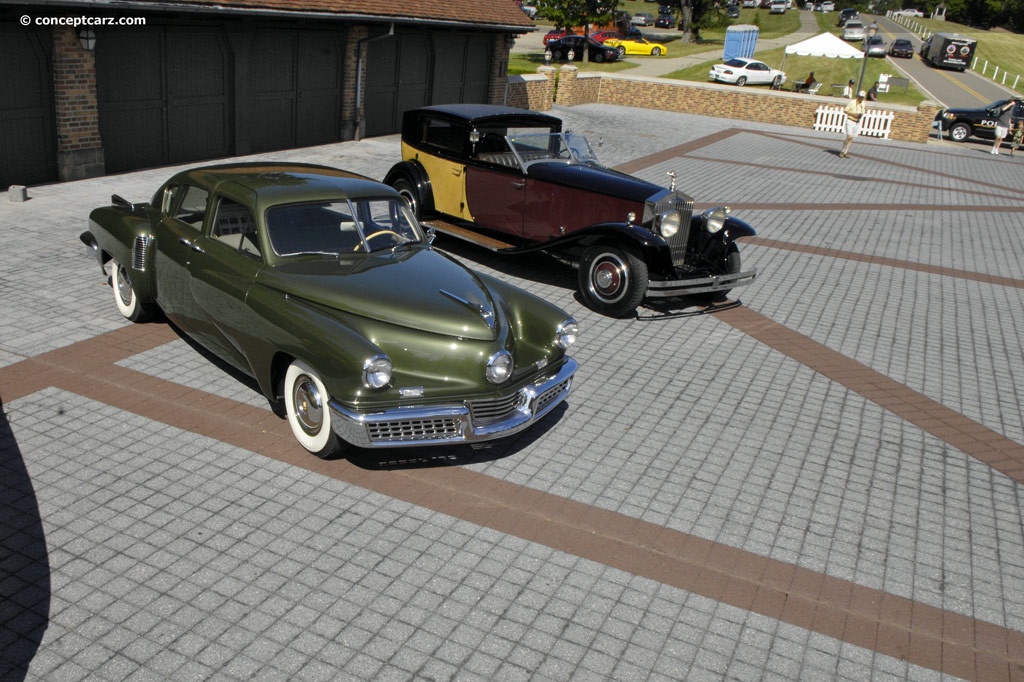
Sedan
Chassis #: 70052026013
Engine #: 1036
View info and history
Auction entries : 2
The December 1946 issue of Science Illustrated magazine showed an early Tucker rendering of a design proposal created by George Lawson. There was a photo of a 1/8 scale model blown up to appear full-sized, titled the 'Torpedo on Wheels'. Well received by the motoring public, stylist Alex Tremulius was hired by Tucker on December 24, 1946, to complete the prototype design. Tremulius was given six days to finalize the design; Tremulis's preliminary design was approved on December 31, 1946.
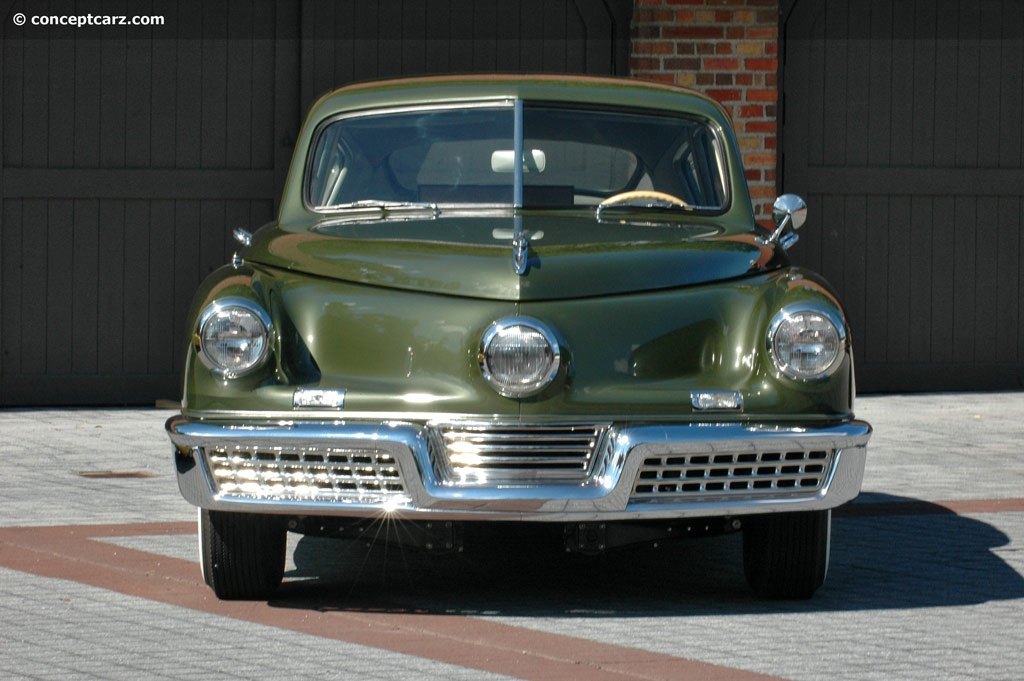
Sedan
Chassis #: 70052026013
Engine #: 1036
View info and history
Auction entries : 2
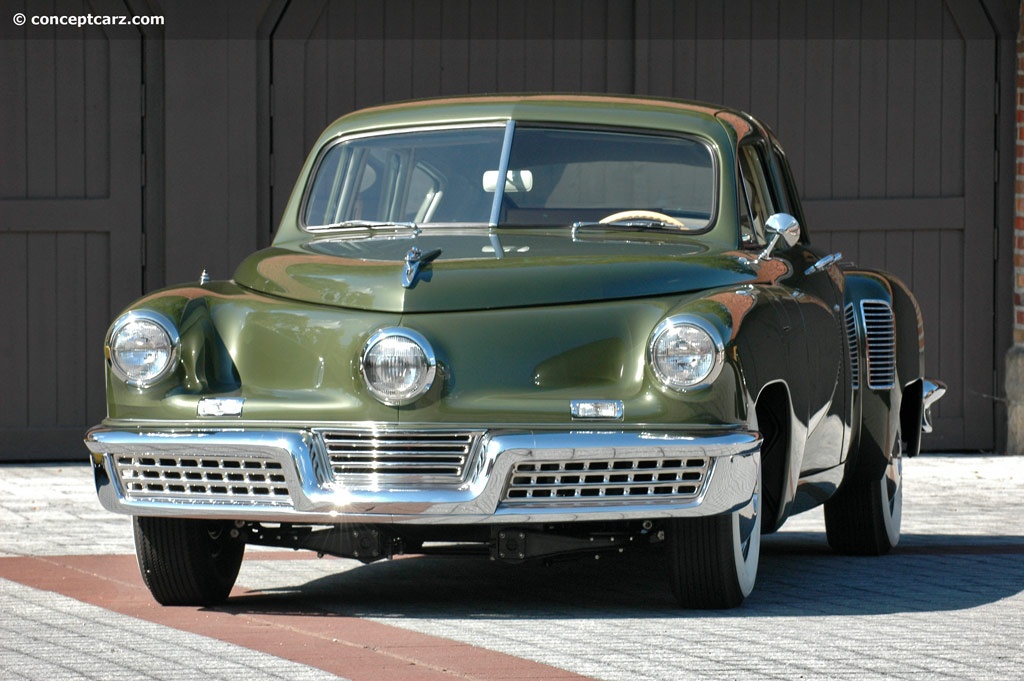
Sedan
Chassis #: 70052026013
Engine #: 1036
View info and history
Auction entries : 2
The Dodge Chicago Aircraft Engine Plant was the largest factory building in the world, and had been used to build the Wright R-3350 Cyclone engines for B-29 Superfortress aircraft during WWII. Tucker and his colleagues obtained the factory from the War Assets Administration with the goal of producing the Tucker automobile under a single roof. The remaining space was intended to be filled by other Tucker ventures, including contracts with the United States Air Force. Needless to say, the lease was expensive, and Tucker needed to raise $15 million in capital by March 1947. This was accomplished by selling dealership rights and floating a $20 million stock issue through the Chicago brokerage firm Floyd D. Cerf. By 1947, the Tucker Corporation had over $17 million in the bank, and although that was enough to satisfy the lease, Tucker was not able to move in until September 1947 due to disputes and counter-claims over the plant between the Lustron Corporation and Tucker. Development of the car was ongoing at Tucker's Michigan machine shop, but the delayed move to the factory meant that Tucker was nearly a year behind his intended schedule. Tucker encountered another delay when the WAA rejected his bids to obtain two steel mills to provide raw materials for his cars.Intended and Actual Production
Tucker estimated that the factory and his workforce could produce - and the market could sustain - 60,000 cars per year. During the first four months, production was anticipated to reach 140 units per day, growing to 300 units per day in the months that followed. Including the prototypes, total production fell far short of those lofty goals, with just 51 examples built before the company was forced to declare bankruptcy and cease all operations on March 3, 1949. A total of 58 frames and bodies were built at the factory. Thirty-six sedans were finished before the factory closed; after the closure but before the liquidation of his assets, Tucker and a small number of employees assembled an additional 14 sedans, for a total of 50. A 51st car was partially completed. At least two (chassis number 1052 and 1057) were not completed at the Tucker factory and are not technically considered one of the original 51 cars. Chassis #1052 was completed in 2015 using parts collected over many years, including the front sheet metal sourced from Tucker #1018. Chassis #1057 was a prototype being worked on by Alex Tremulis for the 1949 model year and was one of eight incomplete body shells (believed to be #1051–1058) left on the assembly line at the time the Tucker plant was closed. In 2010, #1057 was converted into a convertible.
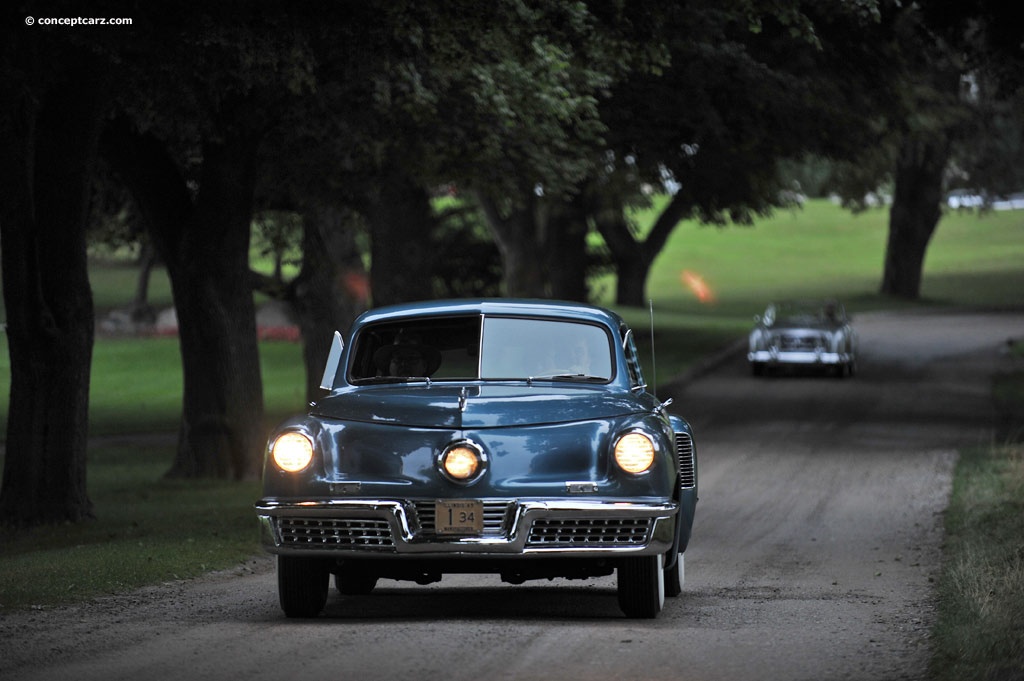
Sedan
Chassis #: 1034
Engine #: 33541
View info and history
Auction entries : 2
The Tucker sedan was futuristic, daring, and sophisticated. Safety and innovation were prominent themes throughout the vehicle, using an unconventional rear engine, rear-wheel drive configuration, and a third, centrally located directional headlamp that would activate at steering angles of greater than 10 degrees.
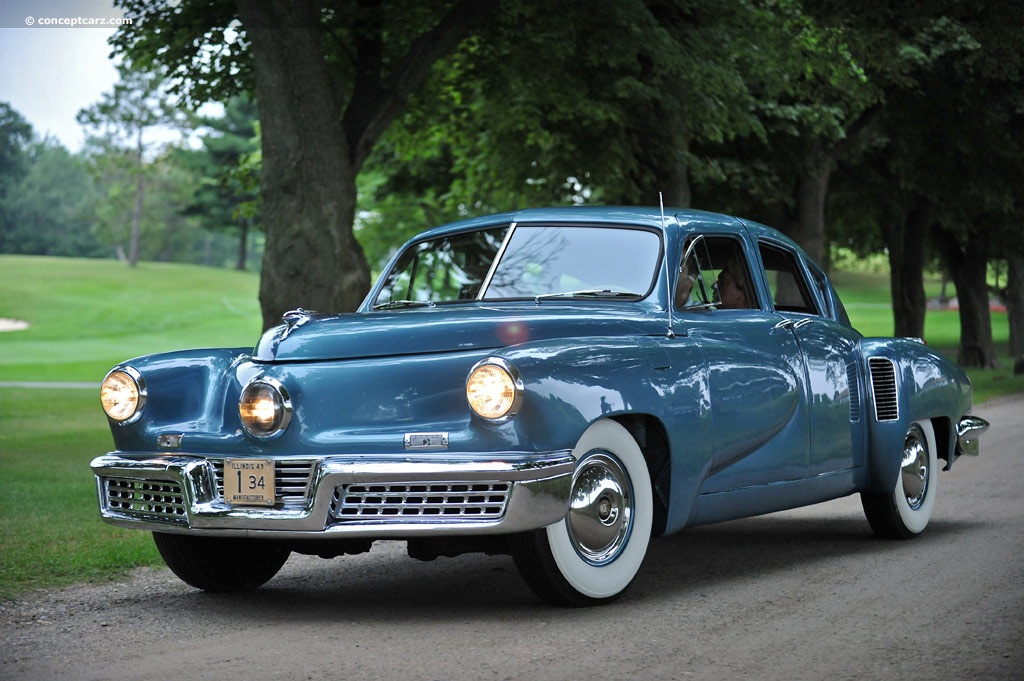
Sedan
Chassis #: 1034
Engine #: 33541
View info and history
Auction entries : 2
The Tucker rested on a perimeter frame and had a wheelbase size of 128 inches, a length of 219 inches, a width of 79 inches, and stood 60 inches tall. The perimeter frame and a roll bar integrated into the roof provided crash protection. The transmission and engine were mounted on a separate subframe, secured by six bolts. Tucker envisioned complete engine swaps taking less than an hour, with the entire drive train being lowered and removed within minutes.The windshield was built of shatterproof glass and designed to pop out in a collision. The steering box was positioned behind the front axle to protect the driver in a front-end accident (one of Preston Tucker's patents was for a collapsible steering column design). The steering columns were donated by Ford and were sourced from the 1941 Lincoln. The center-mounted headlight moved with the steering wheel, providing light in the direction the vehicle would be traveling. The door releases and interiors were from the Lincoln Zephyr. Crash Chamber
The Tucker 'crash chamber' was a padded area ahead of the passenger seat, occupying the location traditionally used by the glove box. This area was designed as a safe, protected area that front-seat passengers could use in the event of an accident. The Tucker did have a glove box, located on the front door panels. The Tucker had a padded dashboard for safety, devoid of protruding buttons and gauges. All controls and the instrument panels were grouped around the steering wheel, within easy reach of the driver. The front and rear seats could be interchanged which aided in the reduction of wear. Discarded Innovation
The Tucker was given many innovative features, but many were attempted or tested and discarded due to complexity, development time, or costs. Among the list of abandoned innovations were disc brakes, self-sealing tubeless tires, magnesium wheels, and a direct-drive torque converter transmission.Suspension
The unique design and configuration of the Tucker required a simiarly unique suspension setup. Problems with stiffness, front-wheel corner lift, and weakness were encountered before a suitable solution was found.
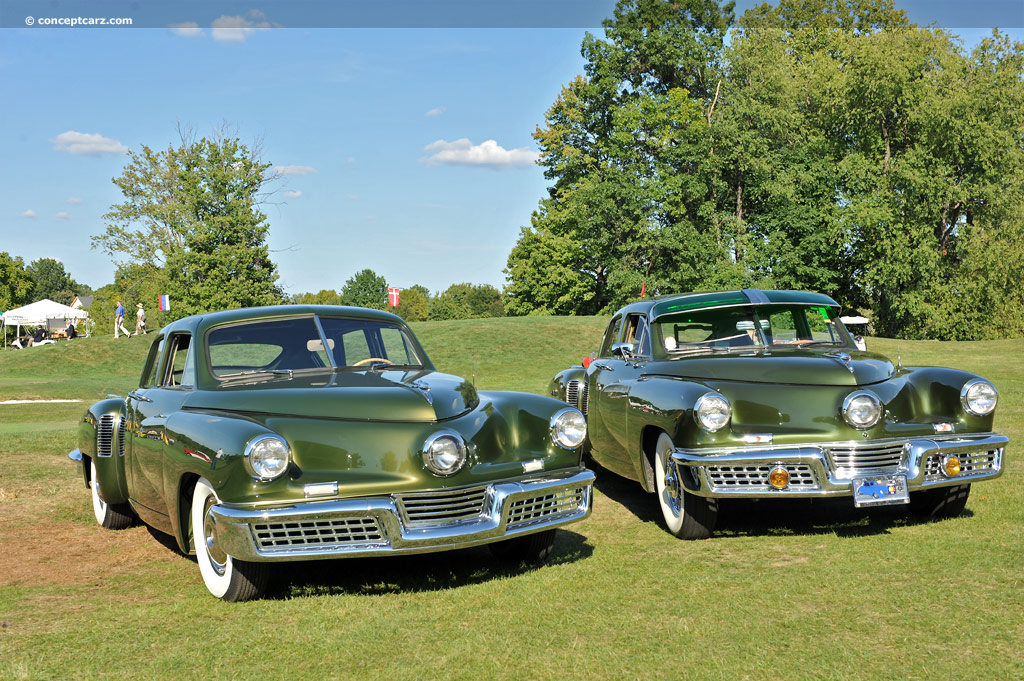
Sedan
Chassis #: 1015
View info and history
589 Cubic-Inch Flat-6
Working with Ben Parsons, then owner and president of the Fuelcharger Corporation, a 589 cubic-inch flat-6 cylinder engine was developed and intended to develop nearly 200 horsepower and 450 lb-ft of torque at only 1800 RPM. It had fuel injection, hemispherical combustion chambers, and overhead valves operated by oil pressure (rather than a camshaft). Each valve was designed to receive appropriately timed direct oil pressure at proper intervals via an oil pressure distributor positioned in line with the ignition distributor. The pistons were built of aluminum and magnesium castings with steel-plated cylinder linings.Six prototype 589 CID engines were built, but were only installed in the test chassis and the first prototype. The engine was extremely loud, and the high-voltage starter required the use of outside power to get the engine started. The high oil pressure required a 24-volt electrical system and up to 60 volts to get it started. Instead of the promised 150 hp, the engine produced approximately 88 hp. The valve train did not work properly at lower RPMs, as the oil pressure required to maintain valve function was not achieved until the engine was operating at higher RPMs.
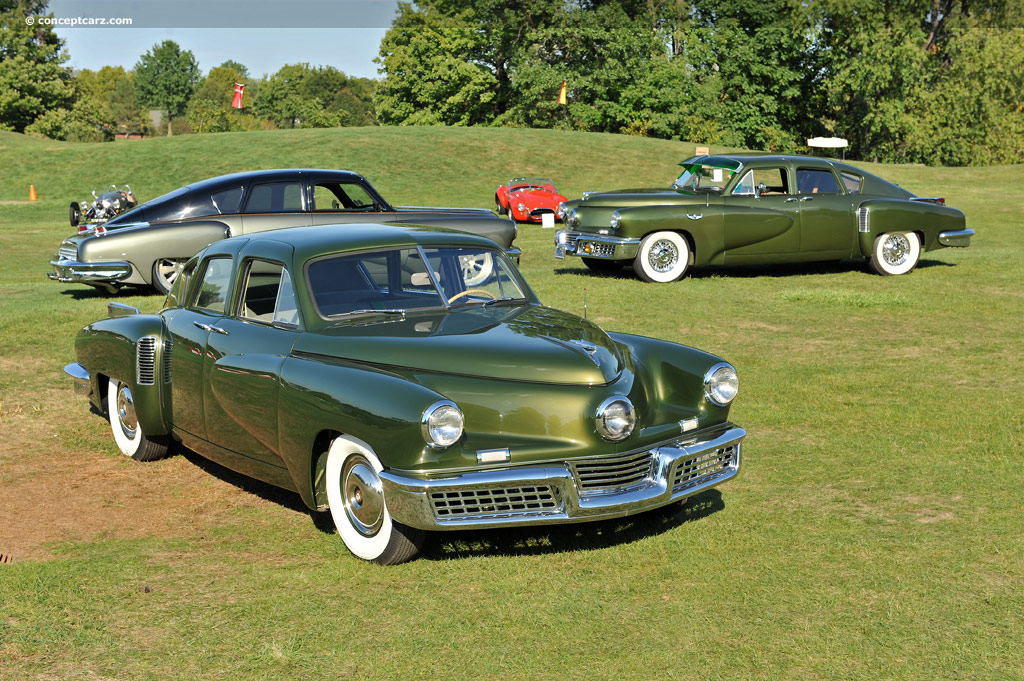
Sedan
Chassis #: 1015
View info and history
The 589 cubic-inch engine was innovative, but its numerous shortcomings sent Tucker seeking alternatives. Nearly a year had been wasted on the 589 CID engine, another setback for the young company. A solution was not easily forthcoming due to the rear engine configuration and size of the engine bay. A Lycoming aircraft engine was attempted, but it was too big and did not fit. A 6 ALV 335 Franklin helicopter engine (flat-6, air-cooled, Franklin O-335 made by Air Cooled Motors) fit, and its output exceeded 150 horsepower (at 166 hp). Tucker purchased four engines at $5,000 each, and numerous modifications were required to adapt the aircraft engine for road-going purposes. For unknown reasons, the air-cooled 334 CID engine was converted to water cooling. The engine required extensive modifications, but it was a workable solution, so Tucker acquired Air Cooled Motors for $1.8 million. Tucker canceled all of the company's aircraft contracts, redirecting all available resources to the production of automotive engines. This was, perhaps, a poor decision as the company forfeited substantial income from the 65% of post-war U.S. aviation engine production contracts it held. The Franklin O-335 engine was installed horizontally with its driveshaft pointed forward, towards the front of the car. Transmission
Cord Transmission
With the engine located at the rear, an unconventional transmission was needed. A workable solution was found using the Pre-Selector (Bendix 'Electric Hand' electro-vacuum shifting mechanism) unit that had been installed in the front-engine/front-wheel drive Cord 810/812. The 4-speed transmission had a reputation for being faulty, but it was a quick solution, designed to point forward towards the front of the car. Installed in the Tucker, it succeeded in getting the cars built and on the road, but quickly proved unable to cope with the power and torque of the O-335 engine. Nevertheless, it worked and had a reverse gear. After searching junkyards and used car dealers, a total of 22 used transmissions were found. They were brought to the Ypsilanti Machine And Tool Company, where they were refurbished and mated to the O-335. Around 18 of the 22 Cord transmissions were usable and installed in production Tucker vehicles.
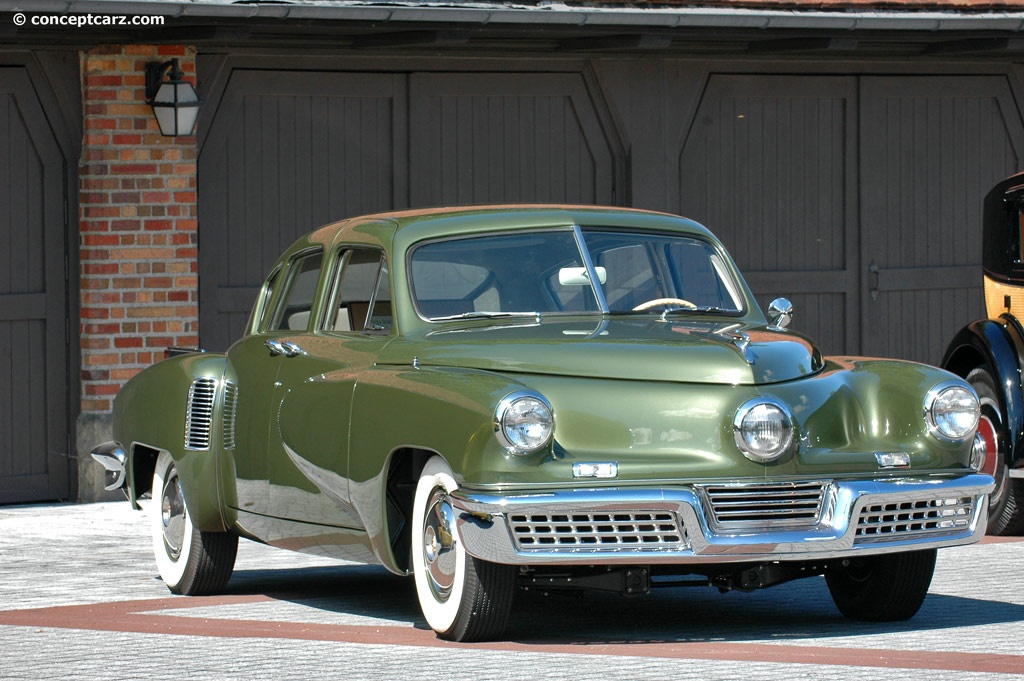
Sedan
Chassis #: 70052026013
Engine #: 1036
View info and history
Auction entries : 2
The Cord transmission had weak gear-teeth, lacked adequate lubrication, and the main shaft often warped under load. Only 22 used examples had been found, a far cry from the planned production of 60,000 cars a year. A suitable alternative was desperately needed.The Ypsilanti Machine and Tool Company was tasked with redesigning the Cord transmission for mass production. Tucker and his engineers used the same basic indirect transmission design but with a lengthened case, stronger gears, and all-new shafts and electro-vacuum controls. It used the Bendix-designed electric vacuum shift mechanism but without mechanical linkage to the steering column shift lever.Dubbed the Tucker Y-1 (for Ypsilanti-1), it was installed in a few Tuckers. Had Tucker production succeeded in greater quantities, these transmissions would have required further development as they suffered from vacuum leaks and electrical connection issues. Tuckermatic Drive Transmission
When the Cord Pre-Selector and the Ypsilanti Y-1 transmissions failed, Tucker enlisted Warren Rice to aid in designing a solution. Mr. Rice was the creator of the Buick Dynaflow transmission, and the solution he designed to cope with the Franklin O-335's power and torque was a unique continuously variable transmission called the 'Tuckermatic.' It had 27 basic moving parts, a single rear-mounted torque converter, and a variable pitch torque converter that allowed a continuously variable drive ratio with two forward gears and a single reverse gear. Since no lower gear selections were necessary, a multi-gated selector was not needed. A single Tucker (chassis #1026) survives with the Tuckermatic installed. Its Tuckermatic R-1-2 unit is one of three different versions of the Tuckermatic made, the R-1, R-1-2, and R-3 (R for Warren Rice, its designer). The first version, the R-1, was not installed on any of the final cars since it required the engine to be off in order to select a gear. The R-1-2 was improved by adding a layshaft brake to allow gear selection while the engine was running. This version was installed on cars #1026 and 1042 only. The R-3 version had further improvements, including a centrifugal clutch to help shift between forward and reverse even further, but it was never installed in any of the final cars. Because the two torque converters on the Tuckermatic made the engine/transmission unit longer, the fuel tank in the Tucker '48 had to be relocated from behind the rear seat to in front of the dashboard for all Tuckers from car #1026 forward, even though only two of them actually had the Tuckermatic installed. The vehicle's weight distribution, however, improved.Chassis number 1026 was a pivotal car in Tucker's suspension configuration, as it was the first to use a modified version of the rubber torsion tube with the tone-in braking problem corrected. Chassis #1025 and prior used mechanical linkage for the Cyclops eye; chassis #1026 and beyond used a new cable-operated system.Chassis #0142 was also fitted with the special Tuckermatic transmission, but it was destroyed numerous years ago.Color
Exterior Paint Color Codes
100: Black
200: Waltz Blue
300: Green
400: Beige
500: Grey (Silver)
600: MaroonInterior Trim Color Codes
900: Green
920: Blue
940: BeigeIntroduction
The Tucker 48 made its world premiere on June 19, 1947, and over 3,000 people were in attendance at the factory in Chicago for the unveiling of the first prototype. Lofty promises had been made, and millions of dollars were invested. Many of the era's greatest engineers and designers had lent their talents in creating the Tucker, and the endless list of problems encountered during development had been corrected. It was not enough; not enough development time and not enough money. The night before the debut, the prototype's independent suspension arms snapped under the car's weight. Repairs were made, and the car made its debut on time, but under the spotlight, it was clearly evident that the Tucker was not ready for production. The experimental 589 engine required the use of outside power to get the engine to start. Tucker's solution was to keep the engine running during the entire event. This may have worked had the engine been quiet. Instead, it was extremely loud. Tucker's solution was to have the band play as loud as possible. The public and journalist's first impression of the Tucker was negative, and its reputation suffered. When the final design was in place, Tucker was able to repair the reputation by showing them in towns across the country. Several cars were brought brought to the Indianapolis Motor Speedway where they were put through a series of endurance testing. Chassis number 1027 was traveling 95 miles per hour when it crashed and rolled three times. The windshield popped out as designed, and the driver (Eddie Offutt) was able to walk away from the crash. A damaged tire was replaced and the car was started and driven off the track, proving to be both safe and durable. Demise of the Tucker Automobile
Preston Tucker had raised $17 million in a stock issue. When more funds were needed, he sold dealerships and distributorships throughout the country. Additional funds were raised through the Tucker Accessories Program, where prospective buyers could purchase accessories to secure a spot on the Tucker waiting list. The list of accessories included a radio, luggage, and seat covers for their Tucker automobile. The Accessories Program raised an additional $2 million. Veterans of World War II were given preference on the waiting list; non-veterans were given a much lower priority. The Accessories Program guaranteed a spot on the Tucker dealer waiting list for a Tucker 48 car. The U.S. Securities and Exchange Commission and the United States Attorney investigated this concept, and although all charges were eventually dropped, the company executives were indicted.Production delays, numerous problems throughout development, a lack of raw materials from a failed bid to obtain two steel mills, a poor public debut, negative publicity, and indictments led to the quick demise of the Tucker automobile. Soon after the Tucker automobiles began rolling off the assembly line in the spring of 1948, the Securities and Exchange Commission began investigating the allegations of mail fraud and other violations. The negative publicity sent the stock plummeting and the facility was forced to close.
by Daniel Vaughan | Sep 2018
Similar Vehicles
Similarly Sized Vehicles
from 1948
Similarly Priced Vehicles
1948 Tucker 48 Vehicle Profiles
Recent Vehicle Additions
Performance and Specification Comparison
Price Comparison
Related Automotive News

The Best of Show at the Greenbrier
The third annual Greenbrier Concours dElegance at Americas Resort, The Greenbrier, was held over Labor Day weekend following a date change and the implementation of new policies surrounding COVID-19. Having this annual celebration of automobiles...

The American-Made 'Car of the Future' Heads to Gooding & Company's 2020 Scottsdale Auctions
A pristine model from the pioneering, but short-lived, Tucker Corporation comes in a rare factory color scheme and offers a well-documented ownership history
Santa Monica, Calif. (November 25, 2019) – Gooding %26 Company, the auction house...

Spectacular 1948 Tucker Model 48 Sedan to be sold without reserve at Worldwide's Auburn Auction
Spectacular 1948 Tucker Model 48 Sedan to be sold without reserve at Worldwides Auburn Auction, with all proceeds benefiting the Mayo Clinic for cancer research
Auburn, Indiana. July 29th, 2019. Worldwide is gearing up for its 12th annual...

Past Best of Show Winners at The Pebble Beach Concours d'Elegance
overview1
The 70th anniversary of the Pebble Beach Concours dElegance was celebrated with a spectacular display of previous Best of Show winners. Thirty-seven examples graced the showfield and many were still with the same owners who raised the trophy...

Tuckers Took to Pebble Beach for the First Time
Theres never before been a Tucker 48 on the fairway that serves as the competition field at Pebble Beach, but on Concours Sunday, Tuckers took to that turf in droves. An original Tucker test chassis, displayed courtesy of the Antique Automobile Club...

Singer Vehicle Design Celebrates 50Th Year Of 911 With Latest ‘Re-Imagined' Debut At Quail
Newest Handcrafted Restored Customer Car by Singer Evokes Past Racing Glories of Porsche, With State-of-the-Art Content and Peerless Execution.
LOS ANGELES – August 1, 2013 – When Singer Vehicle Design (SVD) displays the latest handcraf...

Barrett-Jackson Flavors Its January Scottsdale Auction With NASCAR Treats
RACING HERITAGE, HIGH PERFORMANCE ARE RECIPES FOR CAR-COLLECTING FEAST
SPEED™ SET FOR 39 HOURS of LIVE COVERAGE STARTING JAN. 15
The great Henry Ford once said, Auto racing began five minutes after the second car was built.
...

Chevy Performance Rolls with Hot Rod Magazine Power Tour
Weeklong drive kicks off with unprecedented access to GMs Milford Proving Ground
Road trip! Its that time of year again for the annual automotive pilgrimage known as the Hot Rod Magazine Power Tour® and Chevrolet Performance helps get it started...
